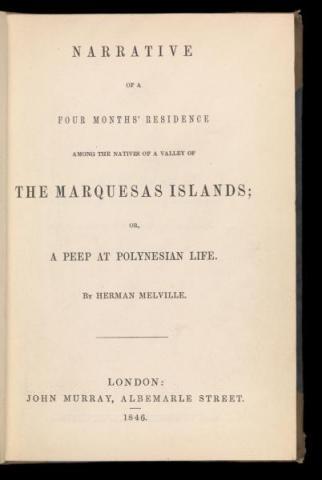Essential Information
| Location |
National Maritime Museum
|
|---|---|
18 Jan 2011
One of the last attempts to seriously portray a known island as a genuinely innocent, if flawed, paradise.

A first book from an unknown author, it sold much better than might have been expected, and was in Melville's lifetime his most commercially successful title, far outselling what would come to be recognised as his masterpiece, Moby Dick (1851).
This may partially be explained by an insistent sensuality that just avoids being explicit enough to attract censorship. Its American publisher, G. P. Putnam, is tellingly reported to have accepted the book because it 'kept him from church' (Delbanco, Andrew, Melville: His World and Work, London: Picador, 2005, p. 67).
It contains much material on the beauty and unabashed nakedness of the women of the valley, who frequently dance for the narrator's pleasure. Indeed, they nightly massage his 'whole body', and there is much about the pleasures of plant extracts being 'applied by the soft palms of sweet nymphs'; a 'luxurious operation' that he 'used to hail with delight'.
Aside from offering titillation, these passages do arguably hold up the inhabitants of the valley as 'Noble Savages', whose morality is simply different from the strict sexual propriety that Melville's audience knew, rather than being non-existent. However, while the book frequently rails against missionaries and imperialism, and sometimes idealises the 'natives', it still reveals unmistakably patronising and fearful attitudes towards them. The plot's tension, for example, comes from an endlessly restated possibility of being the victim of cannibalism.
The narrative is presented throughout as 'unvarnished truth', and certainly the most basic aspects of the story are based on Melville's own experiences in Polynesia.
In 1841, he had joined the American whaleship Acushnet, but deserted with a shipmate in the Marquesas Islands. They lived in the Typee valley for up to a month, but the book’s tales were long ago revealed as wildly exaggerated. However, Melville always vociferously defended the veracity of his book, even appending to later editions a testimony from his shipmate that everything it contained was true. The appearance of truth was assisted by the author’s extensive and shameless plagiarism of ethnographic detail from other sources (notably William Ellis' Polynesian Researches).
Intriguingly, Melville's eventual return to America in 1843 was achieved by enlisting on USS United States, the then somewhat aged veteran of an 1812 action depicted in an item from the Prints and Drawings collection, where it is vanquishing HMS Macedonian.
Ultimately, the book's relation to the strict truth of Melville’s experience is largely irrelevant. Typee, as it would become, was one of the last attempts to seriously portray a known island as a genuinely innocent, if flawed, paradise, and its own accounts of the French and British naval vessels vying for power in the region begin to explain why. Even in 1846, Melville's infinitely remote utopia had not been any such thing for some time.
Richard, Archive and Library